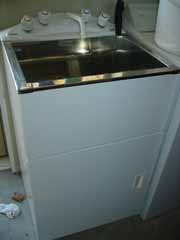Plumbing and Sanitary Fixtures – Laundry Tub
The last of the fittings that hold water is the Laundry tub. An often-overlooked item by designers but as important as any other item in wet areas of the home.
As with all the other items it can come in a variety of finishes such as the traditional concrete hoppers to porcelain on steel.
As for the kitchen, the preference is for stainless steel in an area that items are cleaned e.g. food or clothes.
Nowadays laundry tubs are usually integrated into a metal cabinet with the taps and spout for the tub already fitted and with the taps for the washing machine already fitted. For these fittings there are a few items to check for.
The robustness of the tub. This is an area that will get a great deal of hard use from soaking items with chemical cleansers to someone cleaning heavy boots in the tub.
The taps are likely to be turned when your hands are wet and slippery so close attention has to be given to being able to turn the tap in that situation.
An over flow feature is a must for a laundry tub as the washing machine may empty into it or into a drain incorporated into it.The tubs are large and take time to fill so its likely that the user will walk away and do something else when it is filling.
If the tub has come with a built in cabinet and a storage cupboard underneath then ensure that it has a childproof latch or locking mechanism on it.
The cupboard will very likely be used to store cleaning fluid, soaps, etc. all of which are poisons.

A simple laundry tub with taps for the tub and washing machine combined.
Another feature is to have a hand spray, which is very useful for spot cleaning. Consider the use of the tub. Is this a young family with babies, an older family with sports playing children or a retired couple?
Note: The clients all have different requirements and you as a designer need to list these and act on them, finding the most practical, economical and aesthetic fitting for the situation. Interior design is not just about aesthetics.
For the selection of all these fittings and fixtures always remember to use this checklist.
Selection Checklist
- Material – What’s it made of?
- Maintenance – How easy is it to keep clean?
- Space – What size is it?
- Practical – What are the ergonomic features?
- Luxury – What are the luxury features?
